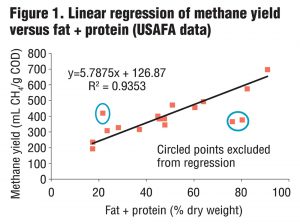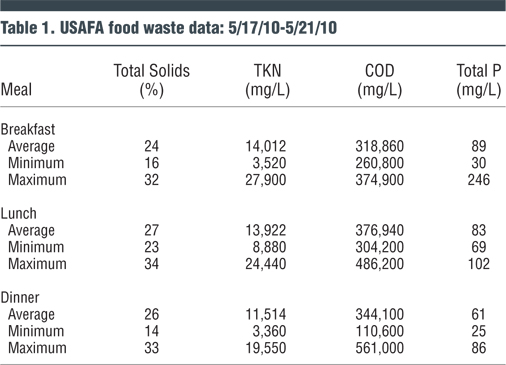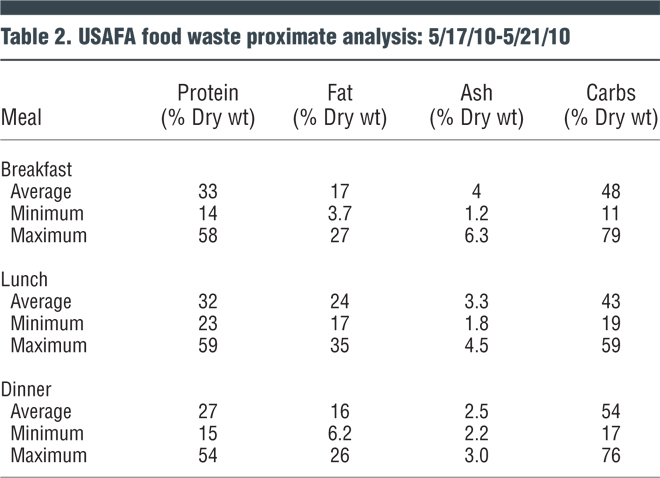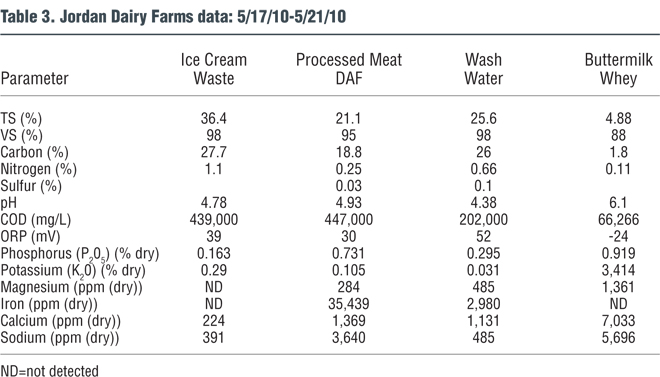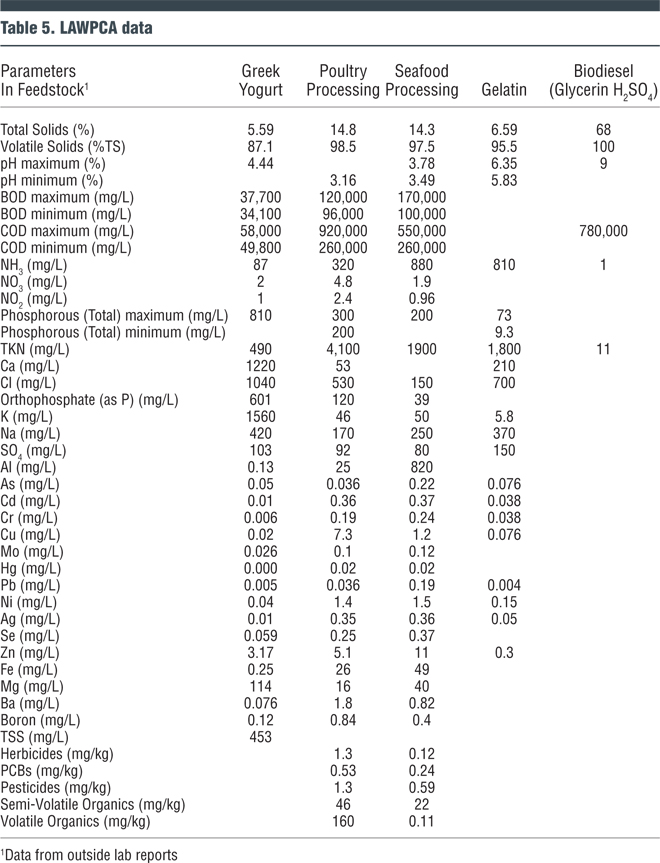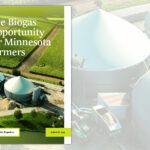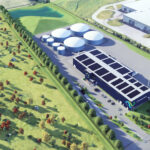Collecting sufficient data on high strength feedstocks for codigestion is essential to the understanding of process impacts and costs, and gaining acceptance from researchers and practitioners.
Vincent Apa and Patrick Evans
BioCycle July 2015
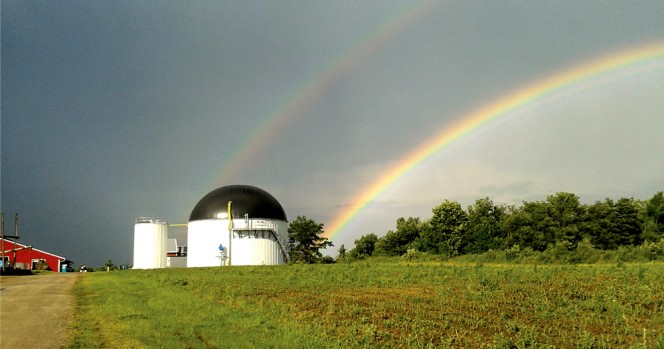
High strength organics used for codigestion at Jordan Dairy Farms in Rutland, Massachusetts include ice cream waste, processed meat DAF, dairy wash water and buttermilk whey. Photo courtesy of AGreen Energy
Water or energy resource recovery facilities (WRRF/ERRF) sample daily for most influent parameters such as biochemical oxygen demand (BOD), chemical oxygen demand (COD), total suspended solids (TSS), volatile suspended solids (VSS), total kjeldahl nitrogen (TKN), total phosphorus (TP), and many others. Testing for biological processes (e.g., nitrification/denitrification) is often performed multiple times per day, or even continuously with online analyzers. On the other hand, most codigestion facilities are designed and operated based on a limited number of samples and parameters.
Without much detailed testing and analysis, facilities historically fed a small portion of high strength feedstocks (HSF) into a digester at a fixed rate and noticed a large boost in biogas production. In addition, most facilities also benefited by the revenue received from tipping fees.
Now, the industry is realizing the importance of sufficient data collection and is bridging the gap. The Water Environment Research Foundation (WERF) is one of the organizations that has been leading the effort over the years. Currently, WERF has three projects evaluating the operational side effects of codigestion, which includes significant data collection on HSF.
Each HSF has its own composition and variability, which can impact the amount and duration of biogas produced. These data are important for biogas collection, dampening, treatment and utilization equipment to gain maximum benefit and economic return. In addition, the HSF properties should factor into how decisions are made with respect to tipping fees, equipment materials for construction, and operational impacts. To further the dialogue, this article focuses on data from four various codigestion studies and operating facilities, and other recommended parameters that are not routinely tested.
USAFA, Fort Collins, Colorado
The Department of Defense Environmental Security Technology Certification Program (ESTCP) funded CDM Smith to conduct a demonstration of anaerobic digestion for food waste treatment and energy recovery. CDM Smith and ESTCP selected the United States Air Force Academy (USAFA) in Ft. Collins, Colorado, as a suitable site for this demonstration. A treatability study was conducted using food wastes collected from Mitchell Hall at USAFA. This treatability study involved the following tasks: Collection and characterization of multiple food wastes; Analysis of food waste digestibility and energy yield in microcosm and bench-scale semi-continuous reactor tests; Assessment of the utility of the specific energy loading rate (SELR) for design purposes; and Testing of food waste hydrolysis kinetics to provide data for calibration of the Anaerobic Digestion Model 1 (ADM1) for use with food wastes.
Data collected for this treatability study included food wastes with and without grease trap waste. From the kitchen hall, food waste was sent through a pulper, then ground and dewatered. Table 1 shows data from this study that illustrates the variability at the USAFA and with food waste in general. A nutritional or proximate analysis was also performed to show the partitioning between macronutrients such as proteins, fat, ash and carbohydrates. Results are shown in Table 2.
Jordan Dairy Farms, Rutland, Massachusetts
AGreen is a joint venture whose members include a Massachusetts dairy farm, a technology provider, a manager/entrepreneur and Casella Organics. AGreen financed and constructed the first farm-based anaerobic digester in Massachusetts, located on Jordan Dairy Farms in Rutland, which opened in 2011. From its beginnings in 2007, the farm participants were motivated by a desire to reduce the odor of their manure through anaerobic stabilization and recover biogas for a combined heat and power (CHP) unit. Since then, the project has grown to include digestion of food processing by-products, and other source separated food scraps and residues in liquid form (e.g. ice cream waste and buttermilk whey), in order to improve the energy output of the digestion facility and provide an outlet for food residual generators seeking to recycle their material. Analytical data on various feedstocks codigested are shown in Table 3.
NYCDEP, Brooklyn, New York
Waste Management (WM) of New York operated an organics recycling facility within its existing Varick I solid waste transfer station in Brooklyn. At this site, organic waste was processed into an Engineered BioSlurry (EBS) using WM’s proprietary and patent pending Centralized Organic Recycling equipment (CORe®) process. The EBS was delivered to the New York City Department of Environmental Protection’s (NYCDEP) Newtown Creek wastewater treatment plant, where it was added to anaerobic digesters to increase the production of biogas.
The Varick I organics recycling facility completed its initial food waste pilot run last year, processing 1.5 tons/day. By the end of 2015, NYCDEP will launch Newtown Creek’s 3-year plan to boost food waste processing capacity from 50 tons/day to 250 tons/day.
Collection vehicles gathered organics mainly from school kitchens. Incoming food waste was tipped from collection vehicles within the enclosed transfer station. Food waste was loaded into the CORe® system’s hopper/conveyor and sent to a bioseparator, which separates organic material from inorganic waste (such as plastic, packaging, etc.). Food waste is liquefied within the bioseparator and then passed through a screen creating a fluidized feedstock. The feedstock settles into the collection hopper below the bioseparator and is then pumped into a blending storage tank to produce the EBS. Table 4 summarizes the minimum, maximum and average characteristics of the HSF added to the Newtown Creek digesters from January 2013 to March 2014.
LAWPCA, Lewiston, Maine
The Lewiston-Auburn Water Pollution Control Authority (LAWPCA) Facility in Lewiston, Maine is permitted to discharge an average daily flow of 14.2 million gallons per day (MGD) and operates at an average daily flow of 12.7 MGD. The influent wastewater is a mixture of residential, commercial and industrial wastewater, generated in the cities of Lewiston and Auburn. Approximately half of the total organic load to the facility comes from the Cascades Auburn-Fiber deinking plant. A new mesophilic anaerobic digestion and CHP facility were built and went into operation at the LAWPCA in May 2013.
The LAWPCA received the first load of HSF in early December 2013. An initial cap of 50,000 mg/L COD was set as acceptance criteria and EPA 503 metals, ammonia, TKN, calcium, magnesium, phosphorous, TSS, total volatile solids (VS), cyanide, and pH were tested prior to acceptance. A local company that buys a majority of the plant’s finished compost was contacted and sourced a Greek yogurt whey at first. A 30-day acclimation period was used before deciding if the HSF was beneficial or not. The facility continued this approach for three additional feedstocks, which include dissolved air flotation (DAF) sludge, and fats, oils and grease (FOG) from a poultry processing plant, DAF sludge from a gelatin manufacturer, and seafood processing waste. The plant now mixes all feedstocks in a receiving tank and feeds a blend to the digesters. Table 5 provides data on the HSF characteristics.
Discussion
The data presented in the tables show a wide variability in the different feedstocks, but also a wide range within the same feedstock. For example, the food waste from the USAFA exhibited large swings in TS, TKN and COD between meals within the same day. Testing performed at the USAFA found the best correlation for methane yield was based on the fat and protein content. A simple linear regression showed an increasing methane yield with increasing fat and protein (Figure 1).
This data is not only critical for proper sizing of biogas dampening, gas conditioning/treatment, CHP systems and piping, but for process stability in terms of how digesters are fed. Simply feeding a digester by a volumetric amount may not provide as much digester process stability as if coupled with additional analyses. Facilities may want to consider sampling the HSF fed to the digesters at least once a day for TS, VS and COD as those parameters are a better gauge on metrics for sizing, performance and operational stability.
COD
COD analysis with bench top units is becoming more prevalent these days. While challenges exist for measuring COD of semisolid or solid samples, it has been found this analysis — when performed correctly — can provide valuable information regarding digester loading and stability. Recently, a specific energy loading rate (SELR) has been developed by Evans and Parry (Evans et al., 2012; Parry, 2014). SELR is expressed as g COD/d/g VSS in the digester and uses VSS as the surrogate for active biomass in the reactor.
Trace Metals
The data from LAWPCA showed a detailed breakdown of trace metals. This is also something to consider, especially if the fraction of HSF to municipal sludge is high (i.e., over 40 percent by mass), as cobalt, nickel and manganese have been shown to be limiting in certain feedstocks such as food waste (Amador et al., 2012; Evans et al., 2012). These metals are also important to inventory periodically for compliance with land application or other biosolids end use requirements.
Sulfate
Sulfate is not often monitored, but some data is shown in Table 5. Sulfate will be reduced to hydrogen sulfide under anaerobic conditions. Also, proteins contain sulfur that can be reduced to hydrogen sulfide following protein hydrolysis. Higher values can lead to additional costs for chemical, biological or physical treatment in biogas conditioning.
Ammonia and Phosphorus
The ammonia concentration is important to monitor also, especially if feed solids to the digester are thin (2-3% total solids) and inhibition of methanogens could occur. A range of inhibitory free ammonia concentrations have been reported in the literature for specific substrates and operating conditions, and thus no single value is listed herein.
From the data for most of the HSFs presented, the fraction of ammonia to TKN is quite low. However, USAFA food waste contained significant amounts of protein, and ammonia concentrations were in the thousands of milligrams per liter. The ammonia and phosphorus concentrations are also important for facilities with low nutrient limits where recycle streams can impact permit compliance or for those planning to do nutrient recovery/harvesting.
pH
The pH of most HSFs is typically below 5.0 standard units. Proper materials of construction should be considered to prolong equipment and infrastructure life. It is common to utilize items such as glass lined ductile iron piping, stainless steel pumps/mixers and corrosion resistant concrete liners or coatings.
Total Dissolved Solids
Although there is not much TSS data provided in this article, most HSFs exhibit a very high dissolved solids fraction, which is beneficial for biosolids disposal as the dissolved solids will not be captured by mechanical dewatering equipment. It is recommended that TSS and TS be measured at least once to determine the fraction of dissolved solids for each HSF.
Acknowledgements
The authors acknowledge the following whom provided data and insight for this article including: Lindsay D’Anna of Casella Organics for the Jordan Dairy Farms, Dan Hagen of Waste Management for NYCDEP, and Isaiah Lary and Travis Peaslee at the LAWPCA.
Vincent Apa, P.E., BCEE, is an Associate and Patrick Evans, PhD, is a Vice President with CDM Smith.



